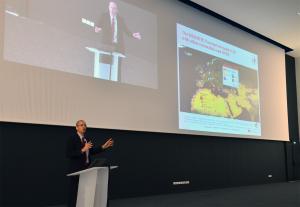Combined with sophisticated heat-storage technology, the power supplied by solar-thermal power plants can be made available day and night, complementing fluctuating renewable energy sources such as wind power and photovoltaics. A low-loss, high-voltage direct current transmission grid would connect—across great distances—the production location with the centres of consumption. These technologies are installed and running in the U.S., Spain, and China.
For the EU-MENA region (Europe-Middle East-North Africa), the Desertec concept assumes, given the political will, that by 2050 a substantial portion of the electricity needs of the local markets and around 17 percent of European energy needs could be covered by power stations in the desert. This would entail estimated investments on the order of EUR 400 billion. " This sounds like a lot, but that's roughly equivalent to Europe's annual oil import bill", the speaker stressed.
Before large-scale solar power plants and wind farms in North Africa and the Middle East with transmission grids reaching across to Europe become a reality, the political course needs to be set, and the first reference plants in the deserts initiated. This is why the Desertec Foundatio started its Industrial Initiative (Dii GmbH) in October 2009 in order to study and, where necessary create the framework conditions to enable international trading in climate-friendly electricity as well as suitable investment incentives. Among the 13 founding members were Deutsche Bank, Siemens, German energy giants RWE and EON, and the world's largest re-insurer, MunichRe.
The involvement of academic and research institutions in the EU-MENA region has since been promoted through the Desertec University Network (DUN) established in October 2010, which reunites universities and research facilities from Morocco, Algeria, Tunisia, Libya, Egypt and Jordan. Its aim: to contribute to the implementation of the Desertec concept.
At the end of his talk Oliver Steinmetz answered many questions on the maintenance of technology and the security of supply. "Delivering energy across borders—sometimes changing borders—is a matter of international cooperation and trust," he concluded. Words that were not unfamiliar to the assembled ITER staff ...
Click
here to download the pdf of the presentation.



